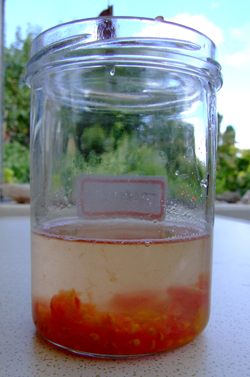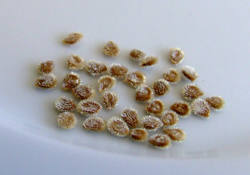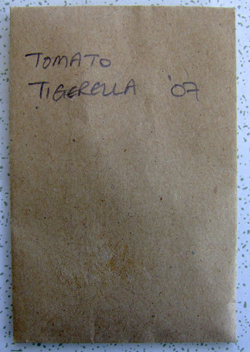Collecting and saving tomato seeds
- without them turning into a solid lump that you can't separate.

Tomato seeds are covered by a soft gel coating and, in their wild state, this stops the seeds from germinating until the gel has rotted away. If you save the seed without removing the gel, it will stick to whatever you dry it on - paper, for example - and will take longer to germinate when sown.
There is a simple method to get tomato seeds that are clean and separate, and it only takes a few days of not doing very much on our part.
What you will need:
-
Some ripe tomatoes - make sure they are fully ripe, undamaged and disease free.
-
A glass jar (or something larger if you have a lot of tomatoes).
-
Water.
-
A fine kitchen sieve.
-
A plate.
How to save the tomato seeds
Halve the tomatoes and scoop the seeds into a jar. Half fill it with water, give it a good stir and leave it somewhere warm.
As the mixture sits warming, it will start to ferment. This breaks down the gel coating on the seed. The water will turn cloudy, mould may form on the surface of the water and it may smell nasty. This is desirable and means the process is working.
After three or four days, stir the mixture and pour off the scum, leaving clean seeds. Any bad seed will have floated to the top and can be tipped out with the water.
Refill the jar, stir again and carefully pour the water away. Do this until there are no more bits in the water, just seeds.
One thing to watch out for - keep a close eye on the seeds because if they have been in water for more than five days they can suddenly sprout. This happened to one batch of mine. I got them out before all the seeds had sprouted, but it was a close call.

Tip the seeds into a kitchen sieve and rinse them under running water. Rub them over the sieve very gently to remove any remaining debris.
Wipe the bottom of the sieve to remove water and tip the seeds out on to a plate. Separate them so that none are touching. Label the plate and put it in a warm, dry place while the seeds dry. This should take no longer than 10 days.

When the seeds are dry, put them in a paper envelope. Seal it and add the tomato variety and the date. Either put the envelope in a sealed plastic bag and keep it in the fridge, or keep the envelope somewhere cool and dry.
Properly stored, the seed should stay viable for between four and ten years.

Keeping seed for more than a year
If you plan on keeping the seed for more than a couple of years, carry out germination tests once a year by sowing a few seeds.
Lay some seed out on damp tissue and keep it covered in a warm place - a plastic box with a couple of holes in the lid, placed in an airing cupboard would do. Check the seed every few days to see how much has germinated. If more than a week passes with no more seed germinating then that gives you a good idea of how viable the seed is. For example, if eight out of ten have germinated, you might want to consider regrowing them and collecting new seed. If only half of them germinate, you should seriously consider starting new plants to collect fresh seed.
Here are some other methods for Collecting, drying and storing seed
© Copyright Miranda Hodgson 2009